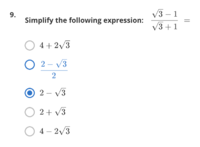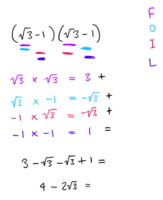So I'm doing an online intro to calculus course, and I've come across this problem:

They want me to simplify a surd expression which is a fraction which has SQRT(3) - 1 on top and SQRT(3) + 1 on the bottom.
So I'm a bit of a beginner here, but I figure maybe the first thing to do is try to get the surd on the top side of the fraction and 1 on the bottom. Then I can simplify the whole thing to just the top part, since any 'x' divided by 1 is simply 'x'.
There seems to be a rule (which I'm still struggling to understand) when multiplying a surd expression by itself, one side of the multiplication has to be the 'inverse' or 'opposite' of the other. I think this is referred to as difference of two squares. So this means that if I have SQRT(3) - 1 on the left side, then I should have SQRT(3) + 1 on the right side, since +1 is the 'inverse' of -1.
So I try it that way:
SQRT(3) - 1 X SQRT(3) - 1
-----------------------------------------------
SQRT(3) + 1 X SQRT(3) - 1
If I'm not mistaken, SQRT(3) X SQRT(3) = 3.
And -1 X -1 should equal just 1.
And 1 X -1 should equal -1.
So I should get:
3 + 1
------------
3 - 1
Which is really:
4
----
2
Which is really:
2
But this is nothing like the actual correct answer (highlighted)!
So I'm trying to figure out - what am I doing wrong here?
Is my error in multiplying both sides by the denominator?
Is my error in how I multiply the surds? Is a SQRT(3) X SQRT(3) not actually equal to 3?
Is my error in how I multiple the coefficients? Is 1 X -1 not actually equal to -1? Is 1 X 1 not actually equal to 1?
Is my error in how I multiple the expressions? Am I doing the multiplication as a whole in an incorrect manner?
I've been searching high and low on Google, using keywords such as: 'surd expression simplify', 'surd fraction top bottom', 'surd fraction simplify', etc, but am unable to find anything matching this problem. All the problems I find online seem to have surds on only one side of the fraction, or don't involve simplification, or are in some other way different from this problem.
I can't believe math is this hard! Maybe I'm missing something really elementary.
But honestly, having been a software developer for 15+ years, this is much much harder than software development. In software, you can Google, read manuals and eventually figure out the answer. But here I feel totally lost. There seems to be no reliable way of finding my way without just giving up and asking other people for help! If anyone can recommend some kind of book or online course that might help, it would be much appreciated.
Maybe I'm just not trying hard enough. Or maybe some things just take time and persistence.
Many thanks ahead of time for any help you can offer!

They want me to simplify a surd expression which is a fraction which has SQRT(3) - 1 on top and SQRT(3) + 1 on the bottom.
So I'm a bit of a beginner here, but I figure maybe the first thing to do is try to get the surd on the top side of the fraction and 1 on the bottom. Then I can simplify the whole thing to just the top part, since any 'x' divided by 1 is simply 'x'.
There seems to be a rule (which I'm still struggling to understand) when multiplying a surd expression by itself, one side of the multiplication has to be the 'inverse' or 'opposite' of the other. I think this is referred to as difference of two squares. So this means that if I have SQRT(3) - 1 on the left side, then I should have SQRT(3) + 1 on the right side, since +1 is the 'inverse' of -1.
So I try it that way:
SQRT(3) - 1 X SQRT(3) - 1
-----------------------------------------------
SQRT(3) + 1 X SQRT(3) - 1
If I'm not mistaken, SQRT(3) X SQRT(3) = 3.
And -1 X -1 should equal just 1.
And 1 X -1 should equal -1.
So I should get:
3 + 1
------------
3 - 1
Which is really:
4
----
2
Which is really:
2
But this is nothing like the actual correct answer (highlighted)!
So I'm trying to figure out - what am I doing wrong here?
Is my error in multiplying both sides by the denominator?
Is my error in how I multiply the surds? Is a SQRT(3) X SQRT(3) not actually equal to 3?
Is my error in how I multiple the coefficients? Is 1 X -1 not actually equal to -1? Is 1 X 1 not actually equal to 1?
Is my error in how I multiple the expressions? Am I doing the multiplication as a whole in an incorrect manner?
I've been searching high and low on Google, using keywords such as: 'surd expression simplify', 'surd fraction top bottom', 'surd fraction simplify', etc, but am unable to find anything matching this problem. All the problems I find online seem to have surds on only one side of the fraction, or don't involve simplification, or are in some other way different from this problem.
I can't believe math is this hard! Maybe I'm missing something really elementary.
But honestly, having been a software developer for 15+ years, this is much much harder than software development. In software, you can Google, read manuals and eventually figure out the answer. But here I feel totally lost. There seems to be no reliable way of finding my way without just giving up and asking other people for help! If anyone can recommend some kind of book or online course that might help, it would be much appreciated.
Maybe I'm just not trying hard enough. Or maybe some things just take time and persistence.
Many thanks ahead of time for any help you can offer!

